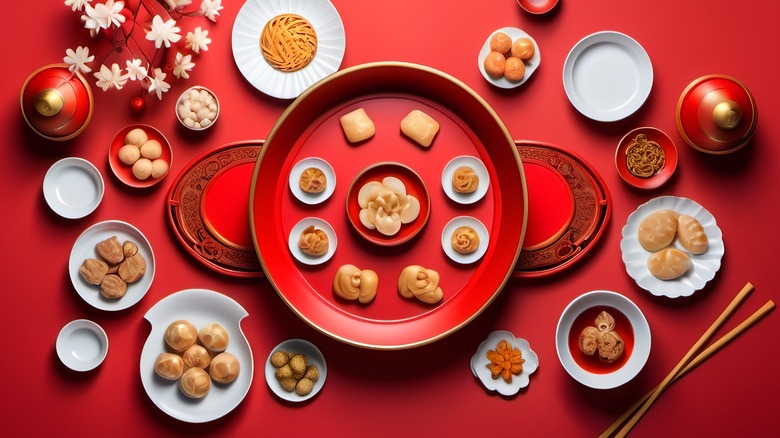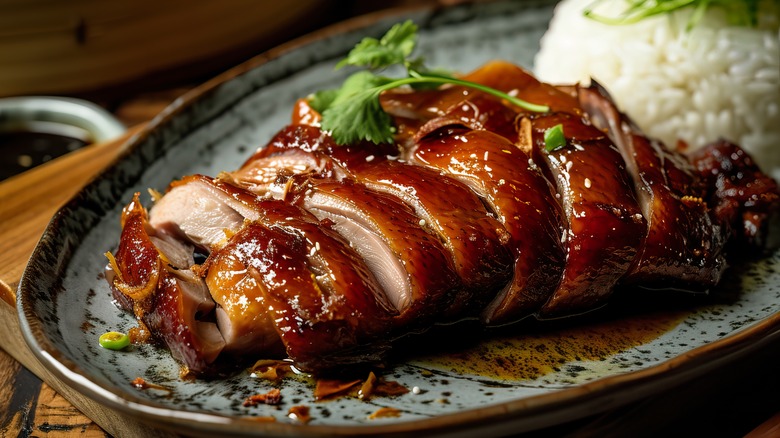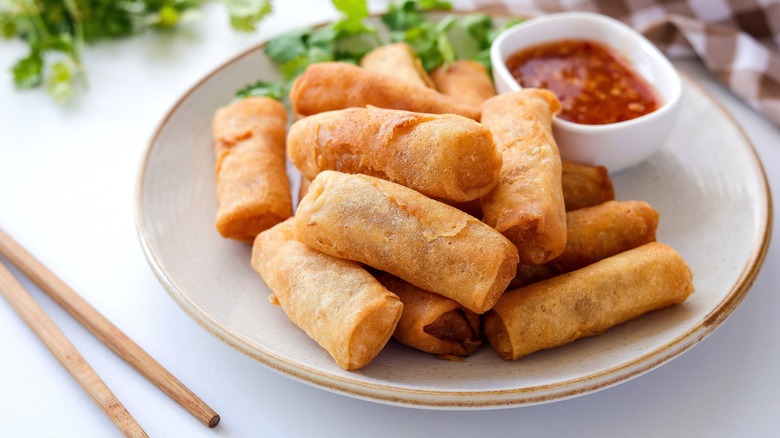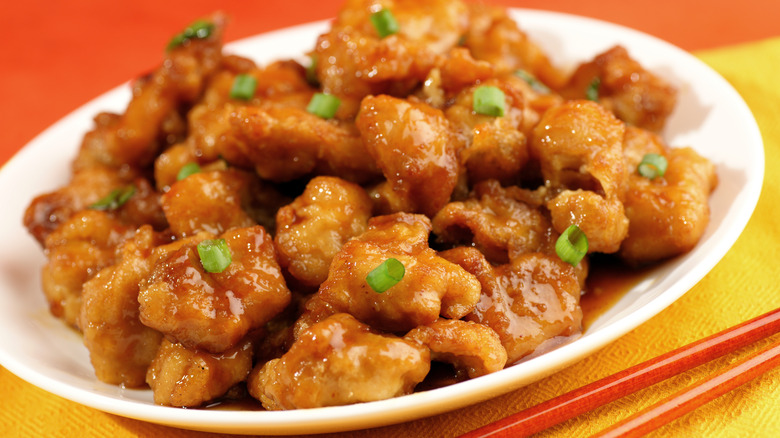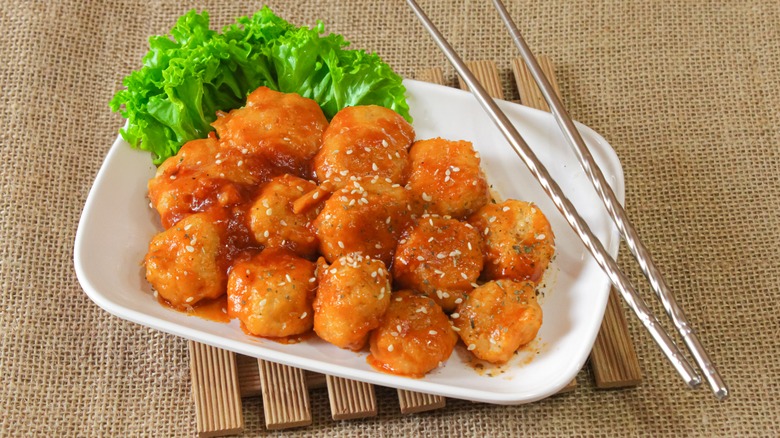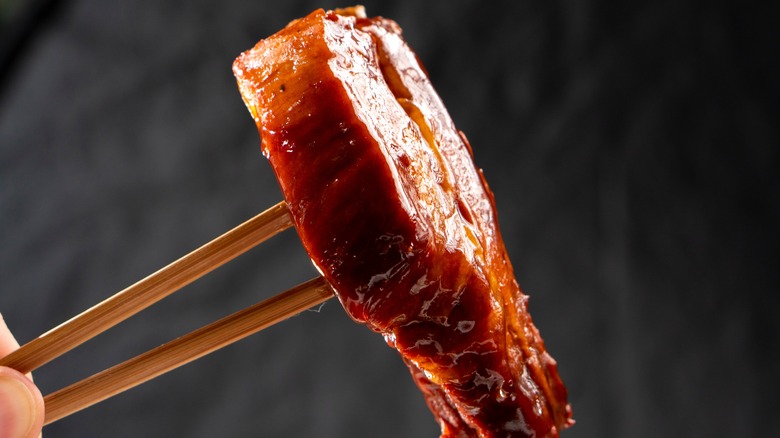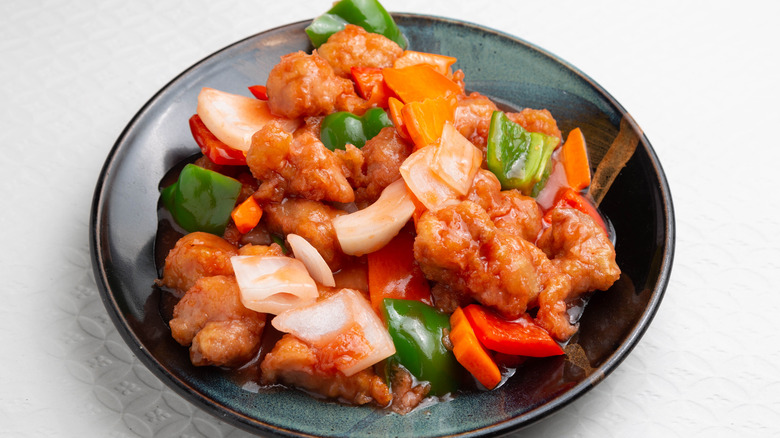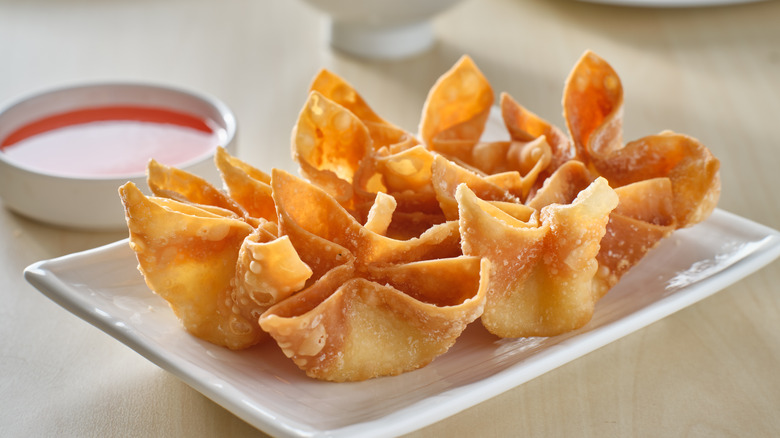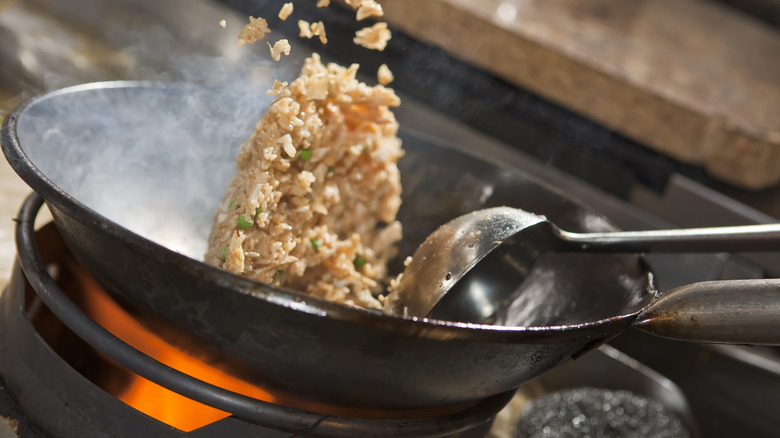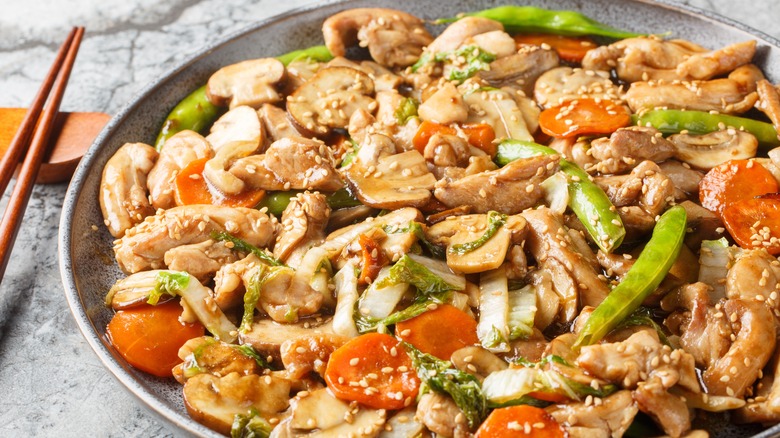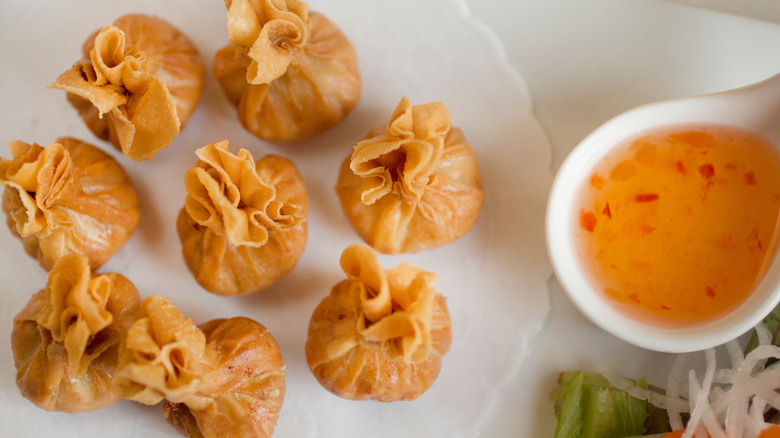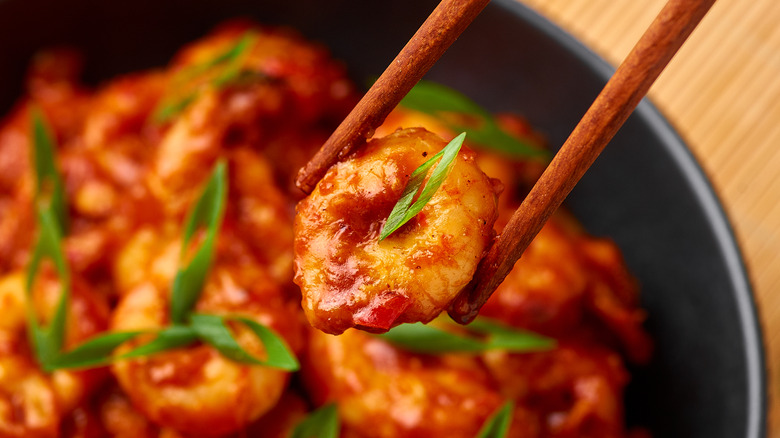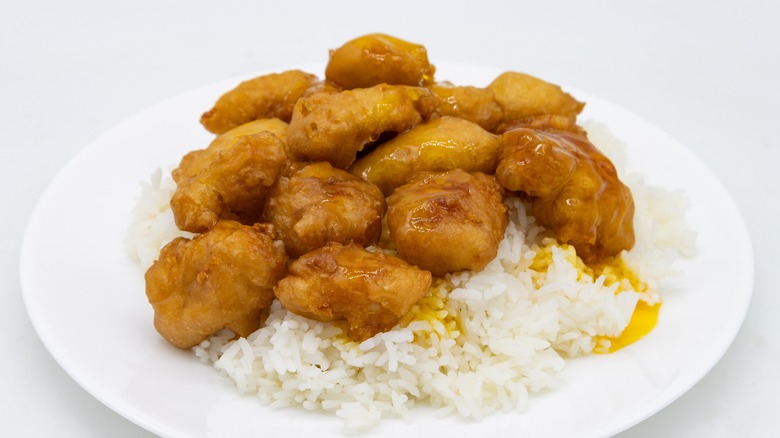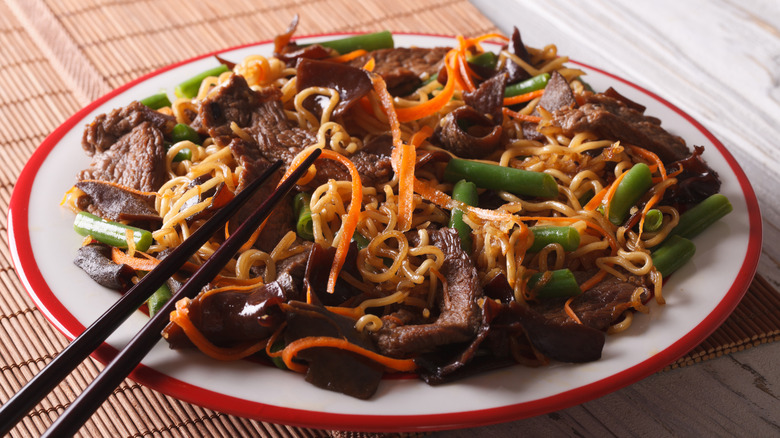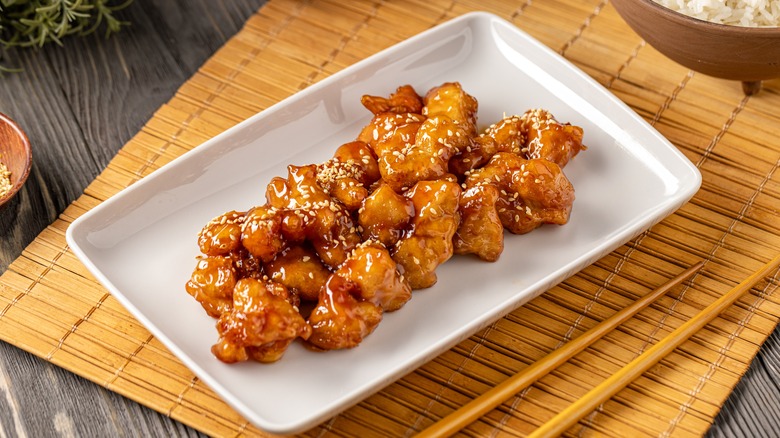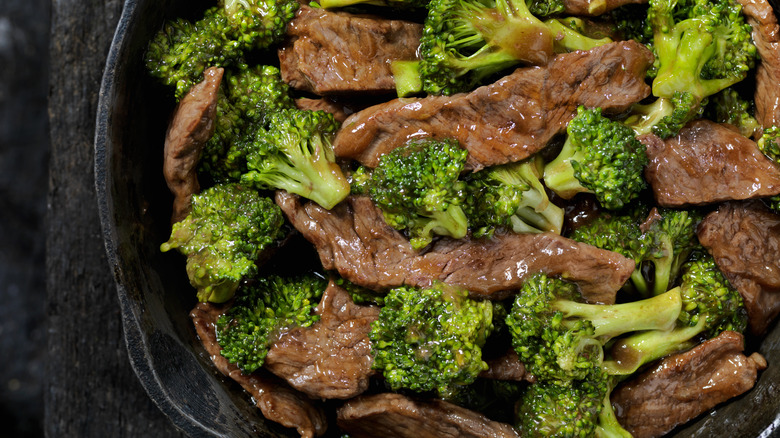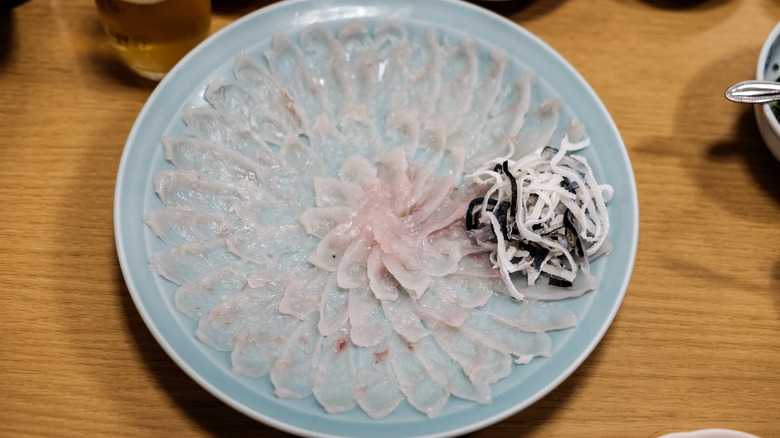Experts Reveal 17 Unhealthy Dishes You Should Think Twice About Ordering From A Chinese Restaurant
There is a rumor on social media that some Chinese restaurants in the United States have a 'secret' menu, available only to those in the know. What's more likely is that some of the 37,000 American-Chinese restaurants operating across the country choose to offer more than the standard line-up of dishes.
Sweet and sour pork, General Tso's chicken, and fried rice are among the staple menu items that U.S. devotees have come to know and love. Yet these dishes can be a pale imitation of Chinese cuisine, we don't even eat them properly and — worst of all — many of them are bad for our health.
We turned to experts Yong Zhao, co-founder and the CEO of junzi kitchen and Nice Day Chinese, registered dietitian nutritionist Sophie Hung, and George Chen, executive chef and founder of China Live in San Francisco, to find out more about the unhealthy dishes to avoid at Chinese restaurants, and what we should be ordering, instead.
Peking duck
This ancient dish has become a gourmet treat, available in just about every U.S. Chinese restaurant. Whether a chef carves up the meat at the table or it arrives ready to eat, devotees love the theatre of Peking duck, as well as the taste.
First, the good news: Duck meat is packed with selenium, iron and B vitamins, as well as "good" fats, while the shredded cucumber or onions served with it are also good for us. Now the bad. Peking duck provides about 35% more of an adult's recommended daily saturated fat intake, and those Mandarin pancakes are packed with carbohydrates.
The biggest health issue with Peking duck is sugar. Slices of the duck's crispy skin are dipped into it, while the pancakes are covered in hoisin or plum sauce, both of which are loaded with the sweet stuff. Registered dietitian nutritionist Sophie Hung suggested asking waiters if they could cut the amount of salt and sauces that come with the dish.
Egg rolls
One of the biggest accusations levelled at Chinese restaurants in the United States is a lack of authenticity. According to Nice Day Chinese co-founder Yong Zhao, much of what's on the menu in the U.S. was designed in the 1980s for American diners, including egg rolls. Traditionally, they are a delicious package of roasted pork, egg, bamboo shoots and vegetables like shredded cabbage. You can even swap out the pork for turkey. What's served in restaurants is often very different.
Egg rolls rack up 220 calories before we even get to the sugar-laden dipping sauces. They're also heavy on the salt, thanks to the seasoning used to add flavor to what can sometimes be poor-quality fillings.
Orange chicken or orange beef
China Live's George Chen said good Chinese food should "use proper techniques, which are vast. Not everything is fried in a wok." Unfortunately one of the most popular dishes in restaurants in the United States is not only cooked in a wok, it can also be one of the most unhealthy.
Whether you order a plate of orange beef or orange chicken, both are loaded with fat and sugar. The meat pieces themselves are dipped in batter and deep fried, before being coated in the orange sauce. A single plate can contain (obviously it depends on the restaurant) around 70 grams of sugar, a whopping 1,900 milligrams of salt, and carry roughly 1,500 calories.
For a healthier option, Sophie Hung recommended scouring a restaurant's menu before booking. As well as ordering at least one vegetable dish and finding out if whole grain rice is an option, she suggested asking the waiter if they could pare back the salt, heavy sauces, and the widely-used condiment MSG.
General Tso's chicken
An American-Chinese invention, General Tso's chicken was created in New York in the 1970s and is one of the four most popular dishes at Nice Day Chinese restaurants, said Yong Zhao. It's similar in profile to orange beef and chicken, with breaded meat that's deep fried before being covered in a sweet glaze.
A plateful of General Tso's chicken has 1,500 calories, 88 grams of fat and more sodium than even the daily recommended total amount. Zhao's restaurants have developed its General Tso's chicken using actual Chinese dishes, rather than the U.S. recipe, to get a similar sweet sour flavor profile. His advice for a healthier option is to share it with friends. "You have just one bowl, right, with that one dish," he said. "It's not balanced. It isn't. It's too much." He added that ordering several different dishes and eating a little of each was a better way to enjoy Chinese food.
Barbecue spare ribs
Sinking our teeth into that blend of crispy, yet squidgy, sweet yet sour meat is what makes us order barbecue spare ribs at Chinese restaurants again and again. This item may be an indulgent treat, it's also one of the most unhealthy dishes on the menu. The trouble starts before they're even cooked; 4 ounces of raw spare ribs contained almost 27 grams of fat.
Some restaurants deep fry their ribs — hello trans fats — before they are coated in a sugar-heavy glaze. There's more sweet stuff in a serving of barbecue spare ribs than a can of soda. For George Chen, the amount of deep-fried food served up in American Chinese restaurants is frustrating. "Chinese cooking uses plenty of steaming, braising, curing, poaching, grilling, roasting," he said. Instead of choosing fatty or sugar-heavy dishes that have been cooked using unhealthy methods, Sophie Hung urged diners to seek out menu items that included "different colored vegetables, whole grain, and lean proteins."
Sweet and sour pork
The sweet and sour pork served in some Chinese restaurants in the United States is a pale imitation of its Asian counterparts. Another heavily breaded and deep-fried dish that's drenched in a corn syrup-laden sauce, it's far from a healthy plateful.
As well as being bad for our blood sugar, that sauce can also be a mask for lower-quality meat that is tough to chew and lacks taste. It turns out sweet and sour pork, like many Westernized Chinese dishes, has evolved far from its traditional Cantonese roots.
"Chinese food was developed as a farmland food," said Yong Zhao, who explained China didn't have many deep fried dishes or ones that relied on sweet and sour sauces. As an alternative to always ordering sweet and sour pork, he suggested eating heavier dishes less often, balancing them with others "so you feel comfortable when you're eating."
Crab rangoon
As with all Chinese food in the United States, there's a range of quality on offer. Crab rangoon has come a long way from its creation in 1940s California in some high-end eateries. However, more often than not, U.S. diners are chowing down on an appetizer that has more style than nutritional substance.
It's not made with real crab of any kind. Instead, it's highly processed imitation crab mixed with cream cheese, lots of salt and sugar. Add into the mix the fact that crab rangoon is deep fried and then dipped into sweet sauces, and it's easy to see why they are high in calories. For diners who can't resist a plate of crab rangoons, Sophie Hung suggests balancing out the appetizer with food that is less salty. "Eat extra veggies/salad or something lighter to balance out the overall sodium intake for the day. Go for a walk after eating out to burn off extra calories," she said.
Fried rice
You can tell a lot about an American-Chinese restaurant by its fried rice, according to Yong Zhao. As a child, he ate his grandma's recipe for breakfast: leftover rice that was safely reheated by being quickly stir-fried with eggs and some vegetables. Today, he uses that as a yardstick. "If the rice is really crappy, it means they really want to get out or the local people don't really care at all," he said.
As delicious and filling as it may be, fried rice doesn't offer much in the way of nutrition, and that hefty dollop of carbohydrates will send your blood sugar soaring. There are ways to make it more wholly nutritious for your body. As well as incorporating more vegetables, as per Zhao's breakfast recipe, and stir-frying it in a healthy oil such as avocado oil, as recommended by Sophie Hung for home cooks, it's also worth asking your local Chinese restaurant if they can switch out the traditional white rice for heart-healthy brown or multi grain types.
Moo goo gai pan
"Cuisine should respect the culinary history, cultural relevance and why/how it originated and evolved," said George Chen. Traditional moo goo gai pan has its roots in China's Guangdong province, and was a stir-fried combination of chicken breast, mushrooms and vegetables, including water chestnuts and carrots.
All of that sounds delicious — but it hasn't translated well to the American-Chinese version that emerged in the mid 19th century. The 37-year ban on Sichuan pepper imports that ended in 2005 did help boost the flavor profile of many a bland dish of moo goo gai pan, but that's not the only problem.
For those expecting the traditional dish, they'll be sorely disappointed to see the white sauce that smothers the Americanized version of the dish, compared to the traditional lighter one. Although it is made without soy, a crisp stir-fried plate of chicken and mushrooms is better for the taste buds and most people's nutritional goals.
Fried wontons
Who doesn't love a delicious wonton or four? They can be steamed or fried and are filled with pork, chicken or seafood. Dip them in that iconic sweet and sour sauce and you're in Chinese food heaven. They've been popular for centuries in China and are equally as beloved in the United States.
Sadly, these little nuggets may be tasty, they don't bring much to the table, nutritionally. They do pack a sodium punch, with 88.7 milligrams in a single wonton, but other than that, they don't have much else going on in the nutrition department.
Fried wontons also ramp up the risk of contact with trans fats, not to mention the allergen risks posed by both the flour used to make them and the seafood fillings, and the sugar hit from the dipping sauce you may not be looking for at dinnertime. Switching from fried to steamed wontons in a soup can reduce your fat intake, but still be aware of the potential salt levels.
Sichuan shrimp
According to Sophie Hung, people in the northern regions of China, where it is colder, eat more spicy food to keep warm. Sichuan food, underpinned by the spicy, numbing Sichuan peppercorns, have made the region's cuisine a favorite for millions of people, including the United States.
The Americanized version of Sichuan shrimp that is served in lots of Chinese restaurants may do well in the spice stakes, but it's far from being the healthiest option. A 222-gram portion of the dish has 252 calories. The shellfish dish also contains 84% of an adult's daily value (DV) of cholesterol, as well as a whopping 1,645 milligrams of salt, equating to 75% of the DV.
Yong Zhao recommends opting for steamed fish with some light stir-fried rice, instead. According to him, the best fish dishes come from restaurants that have stocked fish tanks — and not just for decoration. "The fish should be alive before the cooking," he enthused.
Lemon chicken
Yong Zhao and George Chen agree that two of the key pillars of Chinese cuisine are good quality, fresh ingredients and deep culinary expertise. According to Zhao, back in the 1980s, it was Americans who demanded sugary food that was covered in sauces, and Chinese immigrants who had set up shop in the United States obliged. Thus lemon chicken came to be.
This Americanized version of a recipe that appears in various forms in almost every country, consists of breaded and deep-fried meat, covered in a thick, sweet lemon-flavored sauce. Jayne Hurley, a senior nutritionist at the Center for Science in the Public Interest told Newsweek it was the same as eating "three McDonald's McChicken sandwiches and a 32-ounce Coke." If lemon chicken is your favorite Chinese food treat, Sophie Hung recommended some of her favorites for a more authentic and healthier dining experience, including dim sum, beef tendon noodle soup, BBQ pork (cha shiu), and beef tongue.
Beef lo mein
Lo mein, like stir fry noodles and chicken and broccoli, are among the fundamental American Chinese dishes, according to Yong Zhao. Despite their relative simplicity, they can still be worlds away from their Asian originals, as beef lo mein proves. This dish is overly greasy and covered in a heavy sauce that masks any nuance from the other ingredients. It's not the only thing it hides, either.
Acosta said some restaurants skimp on the quality of the beef and use frozen or artificially tenderized meat that has a weird texture. If that's not hard enough to swallow, lo mein can also be a carb, fat and salt bonanza, with thousands of milligrams of the latter in both the beef and veggie versions.
Although Sophie Hung admits that though Chinese food in the United States has too much sodium, and there aren't a lot of whole grain options available, people can still seek out dishes that help meet their goals at restaurants. "Try to stick to more of the steam and stir-fry dishes instead of the deep fry dishes," she said.
Sesame chicken
Rumor has it sesame chicken was created in the 1980s in Hong Kong at the-then Red Chamber Restaurant. Whether that's true or not, it's become a global favorite. The recipe is relatively simple: Stir-fried chicken strips, garlic and ginger are served in oyster sauce and topped with slices of green onion. Sadly, this is another dish that has been adapted for Western diners and has transformed both taste-wise and in the nutritional department.
Some American Chinese restaurants plump out their meat with breading which, along with a sauce that has been sweetened with corn syrup, masks the presence of low-quality chicken. Luckily there are plenty of tasty alternatives, including Asian greens, which pack a healthier punch, chicken, or bok choy with black bean sauce, or — stepping away from sauced foods altogether — steamed chicken with scallions and ginger.
Fortune cookies
Many dedicated lovers of Chinese food know that fortune cookies aren't a Chinese invention, but they didn't originate in the United States, either. They come from Fukakusa in Japan, home to a Shinto shrine, where local bakers sold souvenir crackers for visitors in the shape of the holy site's bells.
A 19th-century Japanese man, Harigawa, brought them to San Francisco. In the 1940s, they were embraced by Chinese restaurant owners and have become a permanent fixture ever since. Although they might seem like a bit of foodie fun, fortune cookies are produced on an industrial scale, and often stored for a long time before being eaten. You can round off your meal in a more authentic Chinese style with desserts such as a fa gao cake or some feather-light almond tofu, one of the best recipes for this versatile ingredient.
Beef and broccoli
Arguably one of the most popular items on an American-Chinese restaurant menu, beef and broccoli is about as authentically Chinese as pizza. Many eateries in the United States use the thick, sticky sauce to sometimes mask poor-quality beef, but it also ends up overwhelming the broccoli.
Aside from the fat, salt and sugar content in beef and broccoli, it's also got very little to do with genuine Chinese cuisine. The green vegetable was not grown in China before the early 20th century, and it has not exactly taken off since.
To find restaurants that serve quality versions of beef and broccoli, it's worth looking at more than what local restaurants are charging, said Yong Zhao. "Usually there's a picky Chinese population there. So they'll tell you when they eat there more, they will tell you the food is good." He said if none of them eat at an expensive place, you can be sure the food on offer there isn't worth it.
Fugu
Also known as puffer fish, this delicacy is regarded as one of the tastiest Chinese foods — and one of the deadliest. Different parts of some species of fugu contain tetrodotoxin, an odorless and tasteless poison 1,200 times more lethal than cyanide that is not destroyed by freezing or cooking and has no known cure.
Although it's largely banned in the United States, restaurants that have a licensed chef can serve it. Though in 2019, Chinese fish farmers successfully bred non-toxic fugu. The potential for being poisoned at dinner aside, fugu is actually quite good for you, with lots of protein and nutrients (it's a fish after all) and there are lots of ways to have it, from the paper-thin tessa sashimi slices, to tecchiri, or fugu hot pot. That said, it's only available in the winter months and — if you can find some — prices can range from a reasonable $42 to more than $560.
